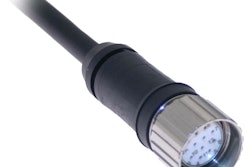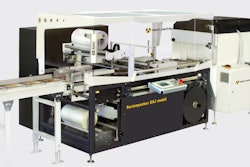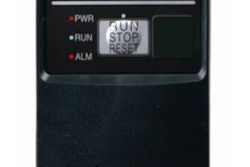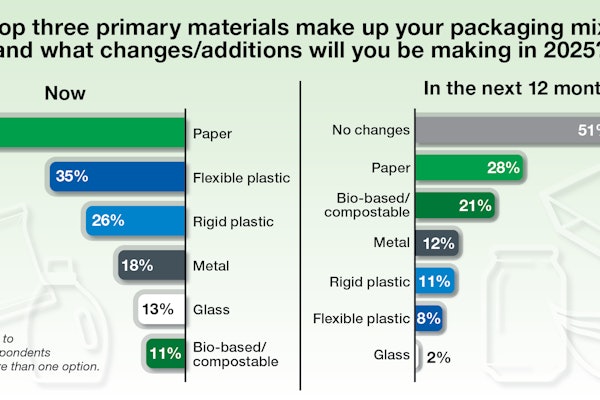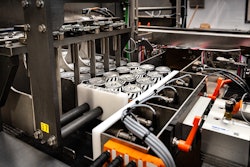Editor’s note: At either PMMI’s Executive Leadership Conference last April or at the PMMI Annual Meeting this fall, I found myself in a number of separate conversations with Gregg Stedronsky and Steve Mulder. Stedronsky oversees Engineering, Global Safety, and Environment at General Mills, while Mulder is the president of packaging machinery OEM Aagard. Both men talked passionately about how valuable a true partnership can be between buyers and builders of packaging equipment. So when both agreed to the idea of being interviewed for a story about the unique partnership that has been forged between Aagard and General Mills, I was, to quote a current ad campaign for a certain insurance company, as happy as a slinky on an escalator. Here then, edited for clarity and mindful of space constraints, is what Stedronsky and Mulder had to say about partnering and about recent changes in the controls landscape.
Packaging World:
Assuming there is a status quo when it comes to machinery builder/buyer relationships, what are someof the shortcomings in that status quo?
Stedronsky: I think one problem is that the word “partnership” is a poorly understood and overused term. So often “partnership” is used during the time when purchasing occurs, as if the act of exchanging dollars constitutes a partnership. While it is true that companies must work together seamlessly during projects, I think partnership is better defined as two companies with a shared vision of the future, a common definition of success, and a real understanding of how their business models can work together over the long term. Another shortcoming in the status quo is that too often companies must buy the same equipment from the same suppliers as their competitors. That makes it difficult to build competitive advantage.
Are there packaging machinery OEMs that are bucking the trend where the status quo is concerned?
Stedronsky: Certainly. Across industry I’m aware of several. For us, a good example is Aagard, one of our packaging OEMs. They understand how to help us build competitive advantage by designing packaging machinery specifically for us. There is a sense of partnership at work. As our relationship unfolded they approached us with a philosophy shaped not by the question “What can we sell General Mills” but rather by the question “How do we help General Mills create competitive advantage?” I think when the relationship is shaped by this it brings together resources from both parties in a stronger fashion.
What does an OEM get out of such a partnership?
Stedronsky: Well, in addition to the obvious answer of being able to sell General Mills a sizeable amount of equipment, I would argue that it enables the OEM to extend and expand their resources. Why? Because if a company like General Mills is simply buying a piece of equipment from a machine builder, then all of the development work and all of the technical detail has to be worked out on that machine builder’s shop floor. But when General Mills is partnering with an OEM, our factory floor, operations people, and engineering teams become available as the OEM’s test ground. They’re able to learn, fail, and propose new methods faster than they otherwise would have. It’s a failing forward model, where you try a machine concept and fix it faster than the competition can come up with the concept in the first place.
Mulder: The partnership helped us drive innovation in a less risky environment. Typically the R&D situation for a machine builder is to look at a market segment that they think they can provide a solution for and then try to design a machine that will fit a wide number of customers. They don’t usually build with one company’s needs in mind as we’ve been able to in this partnership. We’ve certainly taken on some risk on our side, but it was clear that the risk was fairly evenly divided between General Mills and Aagard. The partnership allowed us to push technology much further with less risk than if we were trying to develop a product that we were aiming at a broad part of the market.
Did the partnership emerge rather accidentally and inevitably from your regular dealings with each other, or was it a case of no partnership one day and a partnership the next?
Stedronsky: It didn’t come from traditional engineering relationships. It grew out of key business needs that we had and from some visionary people that resided within that business. The business needed to reduce the capital cost of packaging equipment, reduce changeover time dramatically, remove inefficiencies between packaging unit operations in order to drive reliability and reduce the floor space required by packaging lines. Our business needed something that was not off the shelf, and key operations people inside the business translated that need to some key technical people who were able to work with a new machinery builder that was defining itself as an innovator and wasn’t about mass producing off-the-shelf equipment. That led to prototype equipment, which led to a proliferation of the use of that equipment over the next several years, which led to a partnership.
Mulder: Before the partnership addressed technology or technological solutions, it was addressing business needs, so people from General Mills’s business side were talking with Aagard’s top people about business needs. Once such broader targets were understood, that’s when we started putting smart people on it with execution in mind. They then used the tools that were available at the time and came up with solutions that fit. I’ve spent a number of years at other packaging machinery OEMs where I thought there was a pretty good relationship with General Mills. But with Aagard we seem to talk to a whole different group of people than the project engineering or packaging engineering folks I’d been accustomed to in the past. It’s people in operations or long-term planning. We talk about General Mills’s business needs three to five years down the road. And it’s never a matter of General Mills saying, here’s the packaging material we plan to run on the machine, so give us a machine that will run it. Material specs and package designs are done jointly, in many cases at a point where the machine in questions is still very much in the design phase. The partnership has also been good in terms of being able to plan and make sure our business accommodates their needs because they’re sharing with us a good look at what those needs are, what their capital expenditure is likely to be and so on. There’s an open dialog around such issues.
What should the food industry be thinking as it devises strategies to address manufacturing and operational and packaging efficiency?
Stedronsky: They should be thinking of ways to cope with the proliferation of channels through which food is being supplied, because it’s going to require that food is delivered in new and different formats. I think that as a result, packaging will be a disruptive market force in the decade to come. The challenge for food manufacturers will be to maintain efficiencies of scale while balancing the need for more custom solutions and unique formats. Those formats may mean larger packs in some cases or smaller in others. But what’s clear is that while one-size-fits-all is where we gained efficiencies in the past, a more flexible approach will be required in the future.
The fruits of this partnership are best reflected in an Aagard machine now running at a number of General Mills plants. It takes three pieces of equipment each traditionally its own entity—a bag-in-box cartoner, a case packer, and a palletizer—and combines them in a single machine with a compact footprint and a single controller. But it seems to me that Aagard is more or less known for just that sort of thing, as I can remember seeing very similar machines at Pack Expo in 2010. Those machines were not part of a partnership and were available for purchase by one and all. So in what sense is the machine Aagard built for General Mills the result of partnering?
Stedronsky: That concept that was shown at Pack Expo was not the same system delivered to us. Our version was greatly adapted for the specifics of our product and our manufacturing environment. For example, the controls schema and electronic cam profiles were customized for efficiency in our operations. The mechanics of motion and conveying, the moving of product and cartons, were customized to take into account the characteristics of our materials and the throughputs we were trying to achieve. We sometimes describe the machine development process as having Alpha, Beta, and Commercial stages, where Alpha unfolds at the OEM’s shop, and both Beta and Commercial take place at one of our plants. This machine is a perfect example of that. It followed a process that included a great deal of customization and integration. In the end, we gained things that would have been elusive had we just sent a purchase order to Aagard.
Mulder: You might hear people talk about integrated systems, but typically what they are doing is taking separate unit operations and putting them together so they can talk to each other. Such systems typically have their own controls. But the systems we’re building for General Mills are designed to run with every piece working with the others. So it’s a direct handoff from cartoner to case packer and case packer to palletizer. We don’t let go of package control and then regain it in the next unit operation. We directly pass those things off from one unit operation to the next. It’s one controller governing 40 or 50 axes of motion.
Was it small footprint you were after more than anything else or was it the ability to change to a new package format quickly?
Stedronsky: I’d say it was a blend of both. A small footprint system was probably already out there and available, but it was more costly than we wanted or it was inefficient or it was slow in changeover. The business need that drove the development of this kind of machine was the desire to change over very quickly, almost at the touch of a button, and then get right back to full factory efficiency. That’s why all of that customization that we talked about earlier was so critical, all of it taking into account the product, the factory, and the materials we were running. The other thing about Aagard that appealed to us is that from the earliest days they viewed integration as a fundamental design principle. They really thought that integrating the controls network by centralizing the processing power to drive servo motion would bring about better coordination and better diagnostics. It also led to capital cost reduction.
Can you quantify some of the things you were after?
Stedronsky: Speed and efficiencies are probably a little too sensitive for me to identify, but I will say that our goals were ambitious. In our design goals we wanted to halve capital expenditures, changeover time, and footprint.
How many of these combination machines are out there running in your plants?
Stedronsky: Again, this gets us into a sensitive area. But I can say that once a number of the combination machines were installed, elements of those machines were broadly used to meet other needs across multiple businesses.
A question for you, Steve. Aagard once espoused a strong preference for PC-based solutions, claiming that the computing power and speed typical in a PLC environment was inadequate for the kind of complex, multi-axis motions it was trying to control. But now you prefer the PLC approach. What changed?
Mulder: Computing speed and power. A few years back we could only get the computing speed we needed out of a PC-based controller. What you’re seeing now is PC-level processing power being deployed in a PLC, where they’ve advanced processing speed and power significantly. What’s changed is that complex motion and data management can now be done in a wider variety of ways. There are more tools than the strictly PC-based tools we once felt we had to rely on. A PLC environment offers solutions it once didn’t. And speaking of PLCs, there’s an interesting side note to any account of the partnership between General Mills and Aagard. As that relationship solidified itself, we began to ask ourselves at Aagard why we weren’t having similar conversations with the technology providers whose controls components help us solve business problems faced by the likes of General Mills. Soon enough we launched an Aagard/Rockwell partnership based on the success we had had in partnering with General Mills. Rockwell now shows a willingness to share with us what they’ll be developing 12 and 24 months down the road. So we can have that in view as we come up with plans to meet our own emerging business needs. Those discussions had more impact, really, than any one specific technology that Rockwell was offering. The end result is that after extensive research, we find ourselves going down a road that is essentially a Rockwell one. We’ll still execute with other technology providers, and we continue to enjoy a good relationship with them.
Last question is for you, Gregg. As General Mills continues to enlarge its footprint outside the North American marketplace, what will that mean to your partnership with a machinery builder located just 130 miles down the road from General Mills headquarters?
Stedronsky: It means we will have to extend the focus of our partnership well beyond technology development and give equal attention to technical support. We have Aagard systems in places like Malaysia, Brazil, and Chile. For any technology to help drive a global growth model the provider must lead with support. The technology must be proven, reliable, and easy to maintain within the region. That includes having great documentation, diagnostics, and local support for control systems. It must also meet the capital cost tolerance in that part of the world. To go full circle, the definition of the partnership must be to create competitive advantage for both companies.



